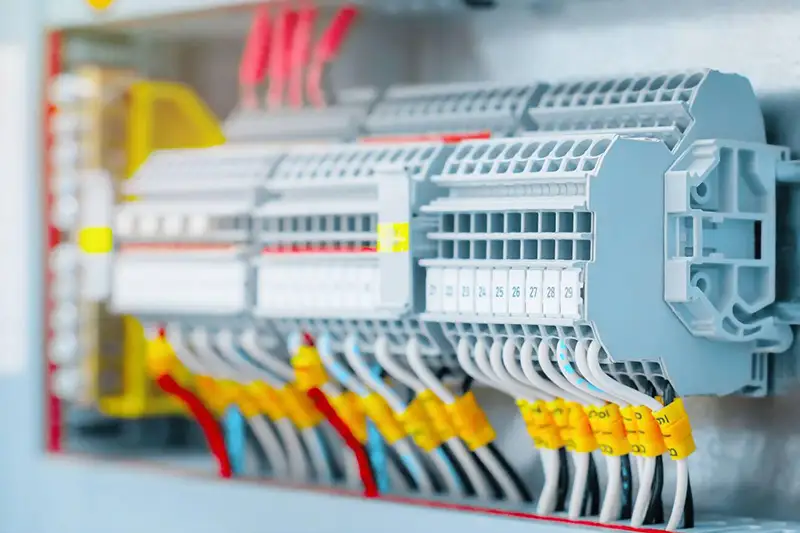Preparing to install an electrical service entrance requires a solid understanding of the process to ensure safety at each stage.
From choosing the correct wire type to securely mounting the meter socket, every step matters.
Properly positioning the main disconnect switch or breaker panel is just as critical, but how can you be certain everything is connected and functioning as it should?
Before testing with a multimeter, there are essential steps that shouldn’t be missed.
Ready to delve into these important details? Let’s take a closer look.
Essential Tools and Materials for Electrical Service Entrance Installation
Before starting any electrical work, it’s crucial to prioritise safety.
Always ensure the power is turned off and use appropriate safety gear.
Essential Tools:
- Voltage Tester: A must-have tool to verify if the circuit is de-energised.
- Wire Strippers: Used to remove the insulation from electrical wires.
- Pliers: For bending and cutting wires.
- Screwdrivers: For tightening screws and terminals.
- Drill: For drilling holes in walls or other surfaces.
- Level: For ensuring accurate alignment of electrical components.
- Safety Gear: Safety glasses, gloves, and non-conductive footwear.
Necessary Materials:
- Service Entrance Cable: Choose the appropriate gauge based on the electrical load.
- Conduit: Protects the wiring and provides a clean installation.
- Junction Boxes: Used to connect wires and provide a secure enclosure.
- Wire Nuts: For connecting wires together.
- Circuit Breakers: To protect circuits from overload.
- Grounding Rod: For grounding the electrical system.
- Electrical Tape: For insulating connections.
- Mounting Hardware: Screws, bolts, and anchors for securing components.
Always consult local electrical codes and regulations to ensure compliance.
It’s strongly recommended to hire a licensed electrician for any major electrical work to ensure safety and avoid potential hazards.
Installing the Service Entrance Components
Safety First:
- Turn Off Power: Ensure the power is turned off before starting any installation.
- Local Codes: Consult local electrical codes and regulations for specific requirements.
Installation Steps:
- Install the Meter Socket:
- Mounting: Securely mount the meter socket to a sturdy exterior wall using appropriate screws and anchors.
- Levelling: Ensure the meter socket is level to prevent water accumulation.
- Weatherproofing: Seal any gaps around the meter socket to prevent water intrusion.
- Install the Main Disconnect:
- Location: Mount the main disconnect switch or circuit breaker panel near the meter socket.
- Accessibility: Ensure easy access for maintenance and emergencies.
- Secure Mounting: Securely mount the disconnect to the wall using appropriate hardware.
- Install the Weatherhead:
- Attachment: Attach the weatherhead to the top of the service mast or conduit.
- Waterproofing: Ensure the weatherhead is properly sealed to prevent water ingress.
- Code Compliance: Verify that the weatherhead meets local code requirements for height and clearance.
Remember:
- Professional Installation: For complex installations or if you’re unsure about any step, consult a licensed electrician.
- Permit Requirements: Obtain necessary permits from your local authority before starting the installation.
- Safety Gear: Always wear appropriate safety gear, such as gloves and safety glasses.
By following these steps and adhering to safety guidelines, you can ensure a safe and efficient installation of your electrical service entrance.
Connecting and Testing the Service Entrance
Safety First
Before proceeding with any electrical work, it’s crucial to prioritise safety.
Always ensure the power is turned off and use appropriate safety gear, such as insulated gloves and safety goggles.
Connecting the Wires:
- Identify Wires: Ensure you correctly identify the hot, neutral, and ground wires.
- Secure Connections: Connect the wires to the appropriate terminals in the main breaker panel, tightening all connections securely.
- Grounding: Connect the ground wire to the grounding bus bar.
Testing the System:
- Turn on the Main Breaker: Once all connections are secure, carefully turn on the main breaker.
- Voltage Check: Use a voltage tester to measure the voltage at different outlets and switches.
- Circuit Testing: Turn on individual circuits one by one to verify their functionality.
Troubleshooting:
- If Issues Arise: If you encounter any problems, such as tripped breakers or faulty outlets, turn off the main breaker and recheck your connections.
- Professional Assistance: For complex issues or safety concerns, consult a licensed electrician.
Remember, electrical work can be dangerous. If you’re unsure about any step, it’s best to seek professional help.
Completing the installation of an electrical service entrance with all connections securely in place is a significant achievement, but remember that safety remains the top priority.
Double-check each step, from mounting components to grounding and testing, to ensure all connections function smoothly.
Although you can accomplish much with the right tools and guidance, electrical work carries inherent risks, and it’s always wise to consult a licensed electrician if you encounter any issues or uncertainties.
With careful planning, adherence to safety protocols, and compliance with local codes, you’ll establish a reliable, long-lasting electrical service that serves your home safely and efficiently.

